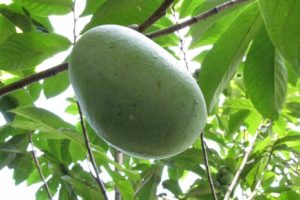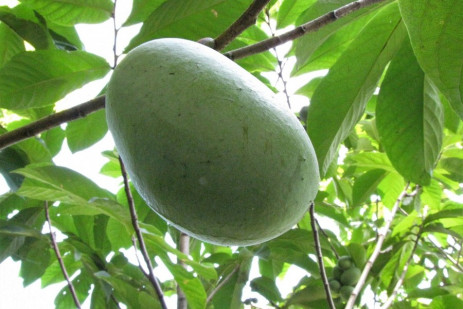
Pawpaws (Asimina triloba) grow well in full sun or light shade and well-drained or moist soils. Trees can reach up to 30 feet in height when grown in full sun with ample moisture. Trees have a graceful pyramidal habit and are draped in light green, 8- to 12-inch-long pendulous leaves. In autumn, the leaves turn soft yellow. Provide the tree enough room to grow as young shoots sprout from the roots and colonize a large area. Remove the sprouts regularly to keep the thicket from getting too dense and blocking out sunlight. The tree is unpalatable to deer, although small wildlife will devour the ripe fruit.
Pawpaws are available from online specialty nurseries as either grafted or seedling trees. Grafted trees produce fruit in two to three years, while seedling trees may take up to 10 years to bear fruit. It is beneficial to purchase two trees as cross-pollination is necessary for fruit set.
Inconspicuous maroon-brown flowers appear in April or early May before the leaves emerge. The wide bell-shaped flowers are approximately 1-inch in diameter and are hang under the branches. While most flowers are bee-pollinated, by flies and beetles, which are attracted to the mild scent of rotting meat. Plants are not self-fertile, so they also benefit from hand-pollination for improved fruit set. When siting pawpaw, be careful not to choose a low-lying area or frost pocket, which will damage the early spring flowers.
Fruits resemble an elongated mango and hang in clusters on one-year-old stems, so older trees benefit from pruning to encourage new growth. The 3- to 6-inch-long fruit matures in September and may be tinged with black blotches when ripe. A ripe pawpaw will also yield slightly, like a peach, when it is gently pressed. Harvest the softened ripe fruit immediately as wildlife will quickly devour it. Ripe fruit is very perishable and lasts only a few days if not refrigerated. Fruit can also be picked before it ripens and laid in a single layer to ripen indoors. As the fruit ripens, it emits an intense fruit aroma—the flavor of the pawpaw. Unripe fruit can also be held in the refrigerator for up to two weeks and then ripened at room temperature.
The fruit has a creamy texture, and the flavor is described as a combination of banana with a hint of mango and pineapple. Pawpaws are very nutritious, rich in Vitamins C, B-6, riboflavin, niacin, folate, and thiamine, and contain minerals such as iron, potassium, magnesium, and phosphorus. To eat a pawpaw, gently rinse fruit under running water, slice it and scoop out the pulp, which has a custard-like texture. The seeds and skin should not be consumed.
The pulp can be used immediately or frozen for later use. To freeze, measure pulp and place in a freezer quality bag, labeled with the amount of pulp and the date. Remove as much air as possible from the bag. Use frozen pawpaws within one year. When ready to use, remove the bag with the amount needed for the recipe and thaw in the refrigerator.
Pawpaws can be treated in the kitchen as you would bananas, pumpkins, or applesauce. Eat a pawpaw fresh and on its own. Bake it into quick breads and oatmeal bars by substituting pawpaws for bananas in your favorite recipe. Make ice cream, sorbet, or even a cocktail.
There are no research-based recipes for canning pawpaws. You can, however, make freezer jam by following the instructions on the box of powdered pectin, substituting pawpaw for a mashed fruit, such as berries or mangos. Once the jam is set, store in the refrigerator for up to three weeks or in the freezer for up to twelve months. Once the jar is opened, store in the refrigerator and use this uncooked jam within a few days.
Pawpaws can also be dried by making fruit leather and are especially delicious when combined with strawberries. See directions for making fruit leather from The National Center for Home Food Preservation.
Due to its reduced shelf-life, pawpaws are rarely available at grocery stores, but you may find them at farmers’ markets. Make a point to try the fruit or purchase plants for your landscape. This native tree provides interest in the landscape, and its fruit provides delight in the kitchen.
Pawpaw Cocktail
- 5 frozen pawpaws (pulp only, skinned and deseeded)
- 2 cups pineapple juice
- 6 cups ice
- 1 1/2 cup light rum
- Drizzle of grenadine
Start with clean counters and utensils. Wash hands for 20 seconds and dry with a single-use paper towel. Blend all ingredients in a blender until smooth and frothy. Enjoy!
Pawpaw Quick Bread
- 1 ¾ cups all-purpose flour
- 2 teaspoons baking powder
- ½ teaspoon salt
- ¼ teaspoon baking soda
- ½ cup coarsely chopped nuts (walnuts or pecans)
- 2/3 cup light brown sugar, firmly packed
- 1/3 cup butter
- 2 eggs, unbeaten
- 1 cup mashed pawpaw pulp
Start with clean counters and utensils. Wash hands for 20 seconds and dry with a single-use paper towel.
Sift together first 4 ingredients, add nuts, and set aside.
Cream sugar, butter and eggs in a mixing bowl. Wash hands after handling eggs.
Stir in mashed pawpaws, then flour-nut mixture, beating until just combined and smooth.
Pour into 1 large greased loaf pan or 3 small ones.
Bake at 350°F for about an hour for large pans, 35 minutes for small ones. Or until done when tested.
Turn out on a rack to cool.





